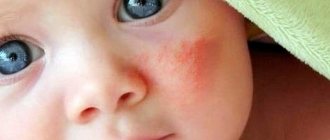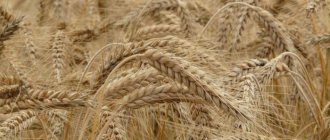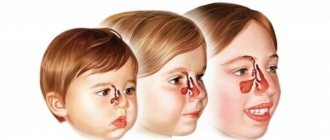Quite often, parents confuse a child’s allergic cough with a cold. Incorrect identification of the source of this unpleasant symptom leads to the fact that the allergy continues to progress and worsen the baby’s condition. The likelihood of an allergen should not be underestimated. If the irritant is not identified in time, a harmless, at first glance, allergic cough can cause serious life-threatening complications, including the development of bronchial asthma, Quincke's edema, anaphylactic shock, etc.
Causes of allergic cough in children
A cough caused by an allergy occurs as a result of the oversensitivity of the immune system to an irritant. The following irritants can contribute to the appearance of an allergic cough:
- household: dust, odors;
- chemical: detergent, shampoos, etc.;
- food: any food product can become an irritant; common allergens include milk, protein, red fruit or vegetables, chocolate, etc.;
- epidermal: feather, down, wool;
- insect: mites, blood-sucking or stinging insects, spiders;
- fungal: white mold, black mold, blue fungi, etc.;
- medicines;
- helminths;
- plant pollen.
In addition to the above irritants, allergies can also be caused by environmental temperature changes: cold weather, frost, wind; instability of the nervous system: excessive anxiety, stress, fear, constant anxiety, etc.
Factors predisposing to allergies:
- genetic predisposition;
- unfavorable environment;
- weak immunity;
- absence of breastfeeding in childhood;
- chronic diseases, etc.
To determine the cause of the allergy, it is recommended to keep a notebook in which to indicate: the time of exacerbation of the allergic reaction, what the child ate, what he washed his hands with, what plants or animals he came into contact with, etc. This will help to quickly identify and eliminate the allergen.
Causes
An allergic cough is not considered a disease, but only a malfunction of the immune system. Perceives various types of harmless elements that penetrate into the body, dangerous ones. This is a rather individual condition, so in some cases a person does not suspect why his symptoms appeared. Often an attack of allergic cough is provoked by the following factors:
- Dust. A large accumulation of dust mites, which is localized in a living room.
- Pollen. During the flowering of plants and trees, a person with an allergic reaction often develops rhinitis. In addition, there are symptoms of a dry allergic cough in a child. Often this can be facilitated by plants such as ragweed, wormwood, and birch.
- Household chemicals. Any chemical can create a negative reaction in the respiratory tract, which can also be a dry cough. Such products include air fresheners, powders, and detergents.
- Pets. Pets can often cause coughing. In such a situation, an allergic reaction is formed to food, wool, and excrement. Detecting its occurrence is quite difficult, since many do not suspect that animals are also a dangerous source of an allergic reaction.
- Fungus. It is localized in rooms where there is high humidity. This variety provokes a severe cough.
- Nutritional supplements. The saturation of flavors and dyes in food products, as well as products that are grown in an unnatural environment or fertilized with nitrates, affect the manifestation of a negative reaction in a person.
- Antibacterial agents. A common reason that provokes an allergic reaction is the uncontrolled use of medications.
In addition, a frequent provoking factor is excessive adherence to hygiene rules, since this provokes a deterioration in the functioning of the immune system, designed to combat dangerous pathogenic microflora. If left untreated, the pathological process can provoke bronchial asthma or laryngeal stenosis, which leads to death.
Symptoms
An allergic cough in a child has several specific symptoms, thanks to which it can be distinguished from a cold:
- sudden appearance;
- often the cough is unproductive (dry); if sputum is produced (usually at night), it is transparent and thick;
- the nature of the cough is paroxysmal, barking;
- long-term course (if the allergen is not eliminated, a cough occurs every time you come into contact with it);
- other signs: suffocation, swelling of the respiratory tract, sore throat, lacrimation, rhinitis, sneezing, itchy nose.
A characteristic sign is also that when coughing there is no feeling of relief.
Types of allergic manifestations other than cough
Very often, an allergic cough is accompanied by the following symptoms:
- Allergic skin reactions - swelling, itching of the skin, rash, urticaria, the extreme manifestation is atopic dermatitis
- Allergic rhinitis - tickling in the nose, itching in the mouth and nose, thin, watery discharge from the nose, sneezing attacks, nasal congestion with decreased sense of smell, sometimes children also experience itching, pain, and tinnitus. Many people experience hay fever in the spring, which coincides in time with the flowering of poplars, and most perceive the malaise as an allergy to poplar fluff; in fact, it is a reaction to the flowering of other plants, but there is no allergy to fluff.
- Allergic conjunctivitis - lacrimation, itching in the eyes, redness and swelling of the eyes, discharge from the eyes is not purulent, but only tears, sometimes there is a burning sensation in the eyes, a feeling of sand in the eyes, photophobia is less common.
- Bronchial asthma - attacks of coughing and suffocation.
- Allergic laryngitis and pharyngitis - they are characterized by hoarseness, burning sensation and a feeling of a lump in the throat.
- Food allergy - usually accompanied by vomiting, diarrhea, enterocolitis, enteritis, as well as skin manifestations, allergic cough.
Where to look for the cause of an allergic cough - the main allergens
Aeroallergens are air allergens that are found in the air in large quantities:
- Pollen allergens are pollen from trees, weeds and even medicinal herbs, ornamental flowers and flowers of vegetables and fruit trees.
- Epidermal allergens - dandruff, wool, animal down and bird feathers.
- Household allergens - book dust, house dust, it contains an abundance of house mites and cockroach allergens. Also all types of household chemicals.
- Allergens of mushrooms - both at home and outside the home.
- Food allergens - this can also be any product, sometimes an allergy is caused not by the vegetable or fruit itself, but by its origin, imported processed fruits and vegetables grown in artificial conditions with an abundance of chemicals can be allergens due to their unnatural cultivation, chemical treatment for extending shelf life, etc.
- Medicines - almost any medicine, dietary supplement can be an allergen.
- Allergens of insect venom - bees, wasps, bumblebees, mosquitoes, midges and other stinging insects.
- Chemical and biological substances from any industrial production.
How to recognize an allergic cough in a child?
Unlike a cough of an infectious nature, with an allergy, a child does not have the symptoms associated with a cold: high body temperature, aches, sputum with pus, noisy breathing. After taking expectorant medications, the allergic cough does not subside and does not become productive (wet). Another distinctive feature of an allergic cough is that its intensity decreases significantly after taking antihistamines (anti-allergic) drugs.
If you have a prolonged cough, you should contact your pediatrician to confirm that the cough is not caused by an infection, but by an allergen. To do this, the doctor may prescribe several studies: x-rays, bacteriological analysis of sputum (especially if you suspect whooping cough), etc.
If you cannot identify the cause of your allergy on your own, you should consult an allergist. The doctor will select a schedule of examinations that will help identify the allergen and determine the general condition of the body:
- general blood test, biochemistry, immunoglobulin test;
- skin tests for allergens;
- ELISA diagnostics, etc.
Only a doctor can assess the need for a particular study, taking into account the clinical picture of allergies and the patient’s medical history.
You can also determine the irritant using special test strips. They are sold in pharmacies and are intended for rapid testing at home. Allows you to detect several allergens at once.
Which cough is considered allergic?
How to distinguish a cough due to allergies from a cough due to a cold? This question interests many, since very often it is impossible to determine the cause of the disease or identify a specific allergen only on the basis of the presence of cough. Most often, an allergic cough occurs after contact with animals, various household chemicals - washing powder, shampoos, soap and toilet paper with fragrances, all cleaning products, especially those containing chlorine-containing substances, as well as pollen in the spring-summer period, perfumes or cosmetics - perfume, cream with fragrances, just house dust or pet care products. In most cases, an allergic cough is accompanied by the following symptoms and signs:
- Allergy symptoms occur suddenly, without other signs of illness, after contact with an allergen.
- Cough of allergic origin usually has a long course, more than 3 weeks without any signs of a cold - fever, chills, weakness.
- In almost all cases, it is accompanied by a symptom such as allergic rhinitis, that is, there is a runny nose, tearing, possibly itching of the skin or mucous membranes, so the throat and nose itches, the person often sneezes.
- Sometimes a cough appears immediately after or during contact with an allergen: for example, in a perfume, cosmetics or carpet store, where the acrid smell of chemical dyes and fabrics causes both an allergic cough and a severe headache in the forehead. And sometimes the cough appears only at night, and does not bother you during the day.
- A cough with allergies is usually dry, without phlegm (causes of a dry cough). Sometimes it may be wet, but the sputum in this case is transparent, not purulent (yellow-green), but colorless (vitreous).
Sometimes difficulties arise in identifying an allergen, since in the modern world anything can be an allergen. But, if you are very attentive to yourself and your health, you can understand what exactly causes an inadequate reaction. Even walking past or along a wide highway with a million cars, a person can start coughing. It has also been noted that a product such as Domestos causes bronchospasm or allergic cough in most people, as a result of poisoning with chlorine vapors, of which there is a very high concentration in this product (Domestos, etc., see how household chemicals affect health).
Food allergies can also cause a cough. There are quite a lot of symptoms of food allergy, in addition to cough, including skin rashes, allergic conjunctivitis, itching of the skin, swelling, redness, diarrhea and even vomiting. Moreover, it is much easier to identify food products to which an allergic reaction occurs than other aeroallergens.
There are cases when ascariasis causes attacks of dry cough within 2 weeks, when helminth larvae in the migration stage enter the lung tissue. Therefore, when diagnosing a cough, possible ascariasis should be excluded (see Ascaris symptoms, treatment).
How to relieve a coughing attack?
During attacks, antihistamines will help quickly relieve cough. You cannot use them yourself without a doctor’s recommendation, because... drugs differ in duration and intensity of action, composition, indications and contraindications (some are prohibited for use by children), and may have various side effects (drowsiness, addiction, decreased muscle tone, etc.).
Classic antihistamines used to relieve allergic manifestations in children are: Fenistil, Suprastin, Tavegil, Diazolin, Loratadine, etc.
Fenistil . Effectively reduces allergic manifestations: cough, itching, inflammation of the mucous membranes. The antihistamine effect appears within 30 minutes. Available in several dosage forms: drops for oral administration and gel for external application. Indications: treatment of allergic diseases, itchy skin, prevention of allergies during treatment with other medications. Contraindicated in children under 1 month, with bronchial asthma, hypersensitivity to substances in the composition. Has a mild sedative effect.
Suprastin. This common antiallergic drug is recommended to be taken even if an allergy is suspected. Available in tablets and injections. The latter are used as first aid in acute conditions, because inhibit the allergic reaction within 5 minutes after administration. Contraindicated in children under 1 month of age, with angle-closure glaucoma, bronchial asthma, arrhythmia, hypersensitivity to active substances. Has hypnotic and sedative effects.
Tavegil is a powerful antihistamine that can be used to quickly stop coughing attacks. It has a long-lasting effect (up to 12 hours). Available in tablets, aerosols, ointments, suppositories, solutions. Prescribed for the treatment of allergic diseases (urticaria, Quincke's edema, allergic rhinitis, etc.), bronchial asthma, bronchitis, dermatological diseases, insect bites. Contraindicated for children under 2 years of age. Depresses the central nervous system (sedation, drowsiness, fatigue).
In acute conditions, which are accompanied by suffocation from bronchial spasm, bronchodilator inhalation agents are prescribed: Eufillin, Ventolin, Berodual . They relax the smooth muscles of the bronchi, inhibit bronchospastic reactions, and reduce the hyperreactivity of the airways that occurs due to the action of the allergen.
Deep causes of allergic cough in children and adults
The pronounced increase in various allergic diseases in people in recent decades is explained by many experts with several theories:
- The Impact of Excessive Hygiene
This theory is based on the fact that with the progressive development of culture, the emergence of hygiene standards, comfortable living conditions, excessive cleanliness in the premises, a person reduces contact with many antigens, while the immune load, especially in children, weakens. The human body is designed in such a way that the immune system must constantly resist and fight a certain number of infections, viruses, fungi. As the workload eases, the body begins a war with harmless antigens, perceiving them as pathogenic organisms. This pattern is confirmed by various studies stating that in families with many children, as well as where there is a dog in families, children are less likely to suffer from various allergic manifestations than in families with only one child and ideal cleanliness (Dogs reduce the likelihood of allergies and atopic dermatitis in children). In developing countries, long-term studies have found that as the welfare of the population and cleanliness in the country increases, there is an increase in immune disorders in the population.
- Antibiotics
How to cure an allergic cough in a child?
Allergic cough in children must be treated in a timely manner so that it is not complicated by chronic bronchitis and subsequently bronchial asthma. Treatment involves, first of all, identifying and eliminating the allergen. And to relieve unpleasant manifestations of allergies, symptomatic therapy is prescribed.
In addition to eliminating the allergen, taking antihistamines to quickly treat an allergic cough and other signs of allergies in a child, therapy should also include:
- Taking long-acting antihistamines (they do not relieve acute allergic conditions in a child, but prevent them): Zaditen, Ketotifen.
- Taking medications that improve the functioning of the gastrointestinal tract and prevent disorders: Smecta, Atoxil (can be added to treatment if it is known that the irritant is a food product).
- Physical inhalations solution or mineral water to moisturize the mucous membrane and eliminate soreness.
- Diet therapy.
A hypoallergenic cough diet will help identify the cause of allergies and reduce the body's allergic reaction. There is a list of foods that are more likely than others to provoke an allergic reaction. These include:
- Plant origin: citrus fruits, red vegetables and fruits, nuts, honey, mushrooms.
- Animal origin: eggs, dairy, fish.
In addition, canned, smoked, pickled, spicy foods, and carbonated water can also cause allergies. Even if the allergen is not food, it is still recommended that the child follow a diet so as not to further irritate the gastrointestinal tract. To do this, you should limit the above foods, salt, and sugar for the duration of treatment. Prepare dishes by steaming, stewing, boiling, baking. Give your child more fluids to help flush out accumulated toxins faster.
Treatment
Therapy for dry allergic cough should be comprehensive, which involves:
- use of antihistamines;
- exclusion of contact with the irritant;
- normalization of nutrition;
- the use of vitamins that normalize the functionality of the immune system and saturate the body with useful elements;
- preventive measures for the development of an allergic reaction;
- use of traditional medicine.
Only by completely eliminating the negative impact of the irritant is it possible to get rid of the symptoms of the disease and improve your well-being.
Drug therapy
Drug therapy involves treatment with the following medications for allergic cough:
- Antihistamines (Zyrtec, Cetrin, Zodak). They do not completely eliminate cough, but they do remove it for a certain period of time.
- Mucolytic drugs. They make it possible to change the composition of mucus in the bronchi, making it easier to remove it from the body.
- Expectorants (allergy drops for children). Helps remove mucus from the respiratory tract.
- Complexes of vitamins and useful elements. They help strengthen the immune system; the cells independently fight the allergen.
Important! It is necessary to strictly adhere to all instructions of the treating specialist. Untimely or ineffective therapy leads to adverse consequences that pose a threat to health.
Treatment with folk remedies
Basic therapy can be supplemented with folk remedies. It is important to consider that they are an auxiliary element and are absolutely useless in monotherapy. Most popular recipes:
- Kalanchoe. The juice of this plant effectively eliminates symptoms such as rhinitis. For these purposes, the nasal mucosa is lubricated.
- Celery root. The juice is squeezed out and consumed in 3 sips before meals, which helps ease the child’s well-being.
- Mumiyo. Dissolves in milk (ratio 1 to 20), after which a small amount of honey is added. Used in the morning and evening.
- Juice. Apple, carrot, and cabbage juices are squeezed out and then taken before meals.











